Custom Destinations
Custom Destinations allow you to “bring your own” SaaS destination to Census. A custom destination is a few simple API endpoints that teach Census about the type of data your destination can process, the operations allowed on that data, and how to actually load that data. You can deploy your implementation to any service you like, as long as Census can reach the URL over the internet. This guide walks you through setting up an example implementation, how to build your own from scratch, and covers all the technical details of how it operates.Demo Destination
To start, let’s walk through the steps to deploy the sample implementation. This will give you a good overview of everything involved in building a custom destination implementation.Prerequisites
- A Census account. If you don’t have one, you can sign up for a free trial here.
- A place to run your Custom API code. Custom APIs have to be accessible via a public endpoint over HTTPS. For this demo, we’ll use Netlify Functions (you can sign up for a free account) . If you’d prefer to test locally, you can also use ngrok or a similar tool to expose your local endpoint to a temporary public URL.
- Your own copy of this sample implementation. It takes care of the JSON-RPC protocol and provides stub implementations of some methods for simple Custom APIs.
Fork the Sample
To deploy to Netlify, you’ll need a git repo with a copy of the sample implementation that Netlify can connect to directly. The easiest way to do this is by forking the GitHub repository. Otherwise, you can clone the repo and then push it to a new repo on GitHub, Gitlab, or Bitbucket.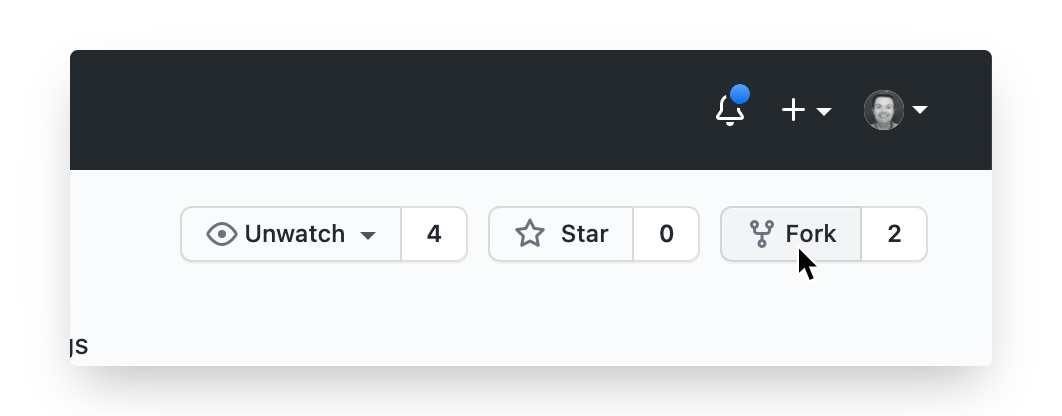
Deploy the Function
Now head over to Netlify. Create a new “Site” and point Netlify at your newly forked or cloned repo.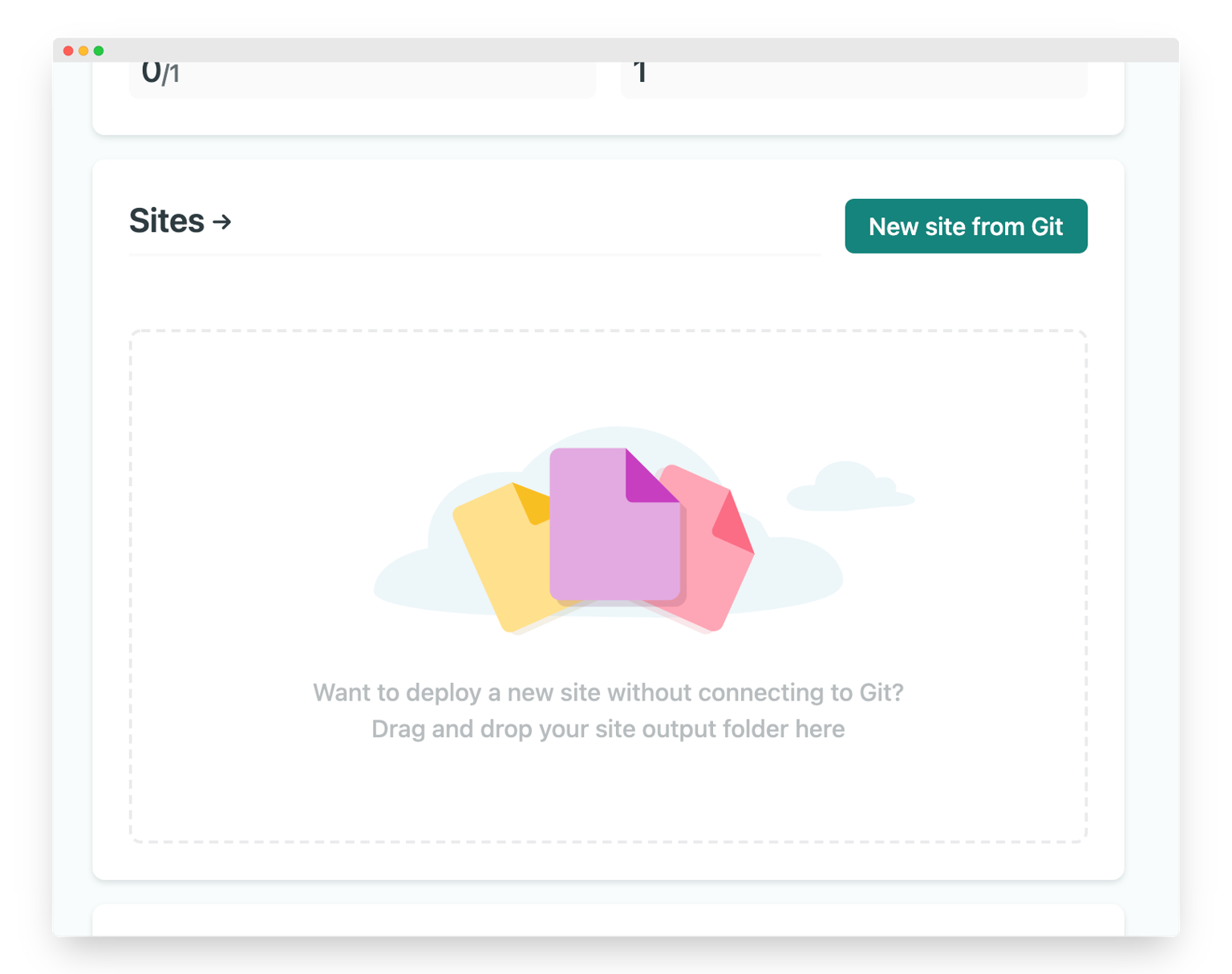
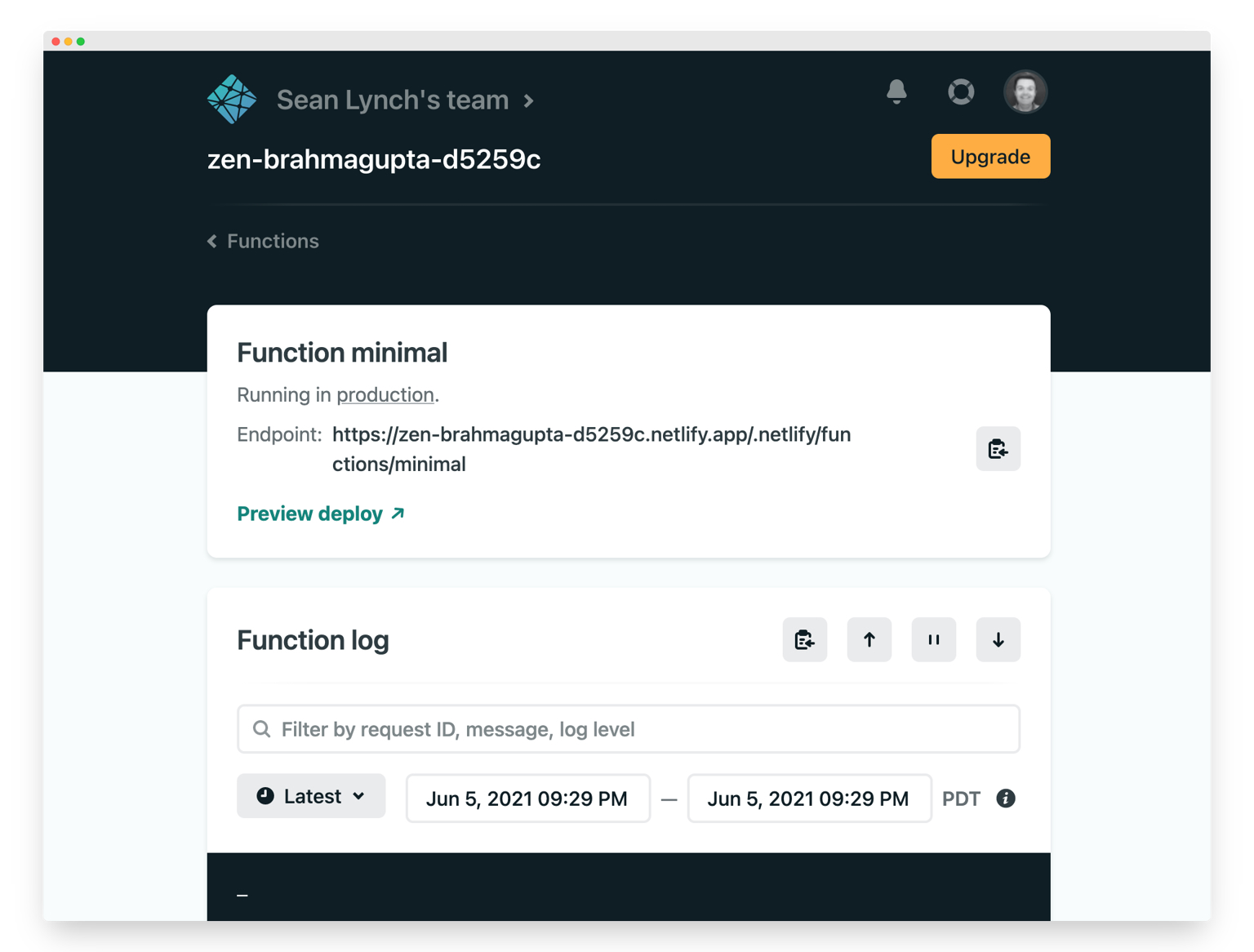
Set up the Connection
Now head to Census, specifically the Connections page. Click New Destination and select Custom Destination API. You can give your new connection any name you’ll remember, and the URL will be the value you copied from Netlify a moment ago. Save your new connection and you should see Census testing your new connection is responding correctly. You should see ✅ in just a minute.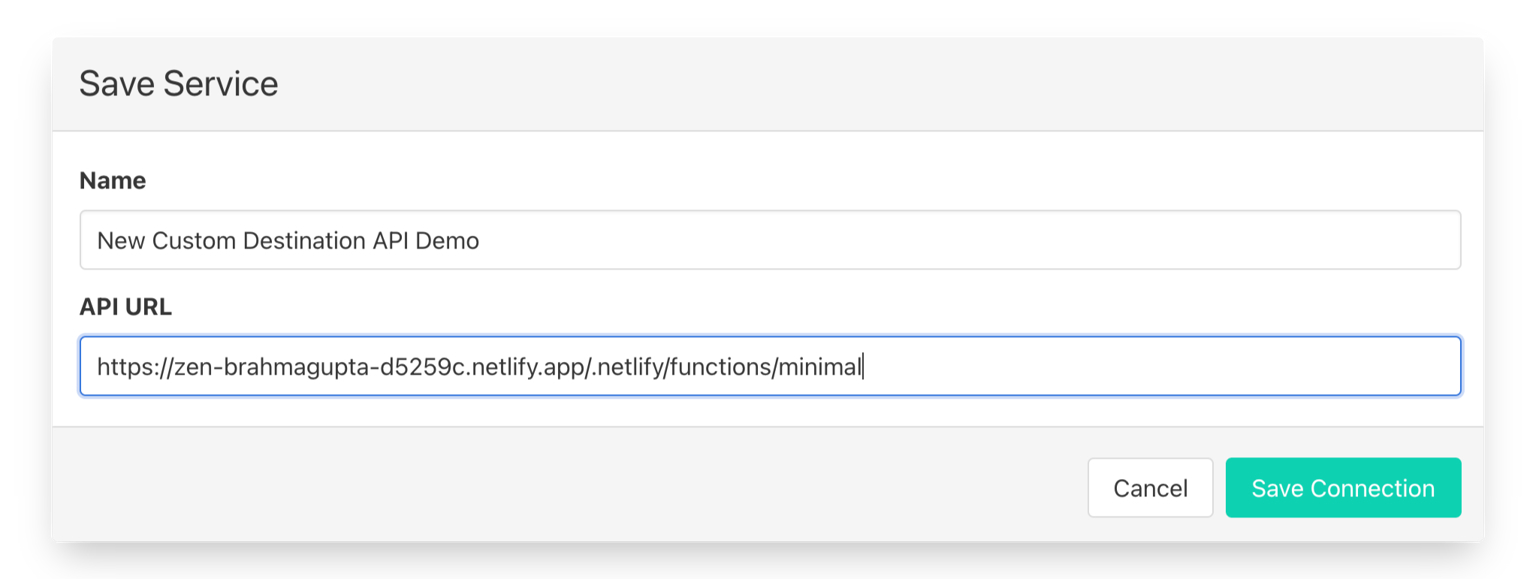
Create a Sync
The last step is to create a test sync. The sample implementation expects records with Email and Name properties, but you can sync whatever table, view, or model you have handy in your data warehouse for now, though you only need a few rows to test. In Census on the Syncs page, click the Add Sync button. Select your test model and your new Custom Destination. You can provide matching email and name fields, or use any other available fields, the data won’t be sent anywhere other than Netlify’s logs. Your sync should look like this at the end. Save it and run it!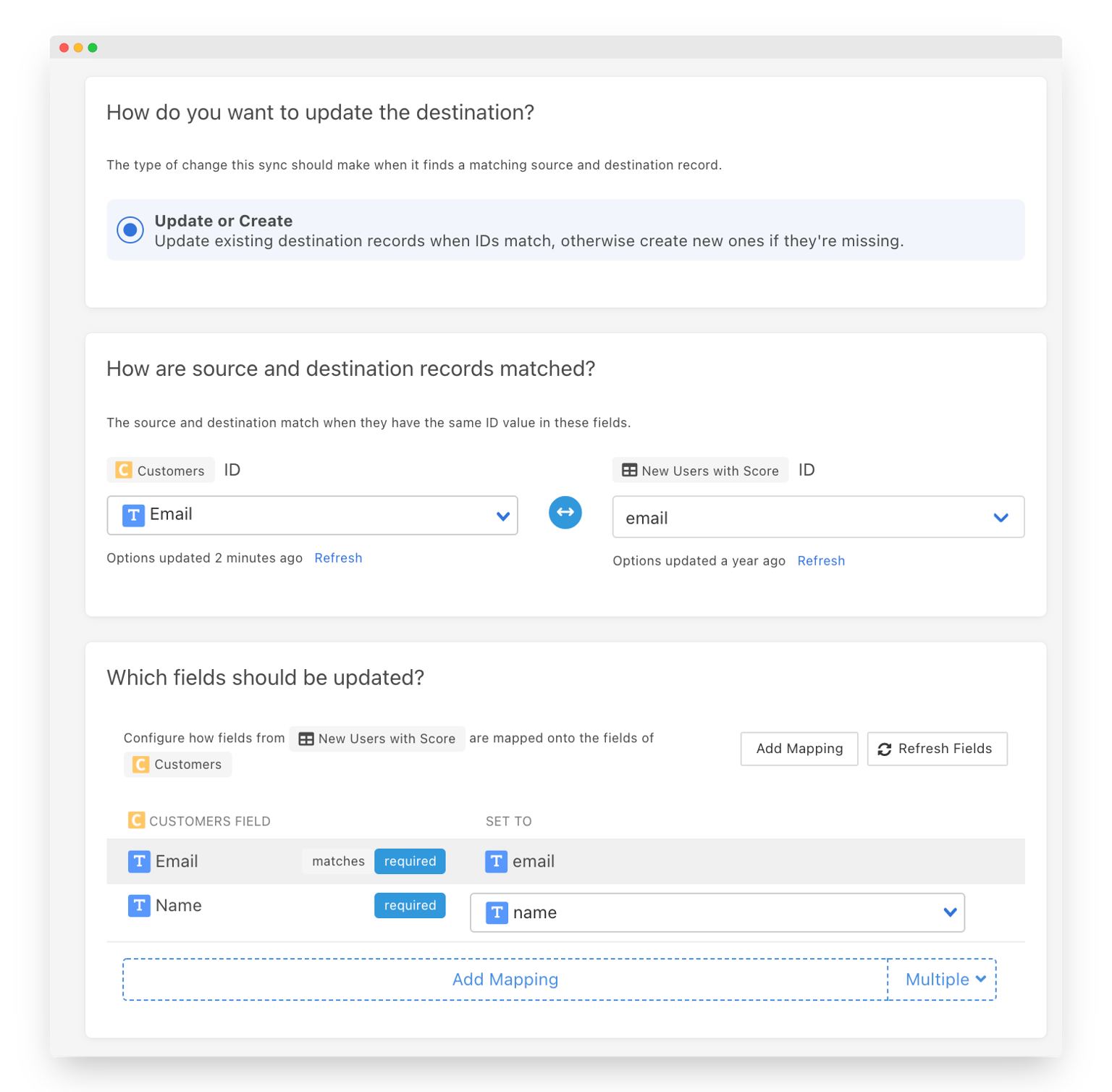
The Results
After your sync is complete, head back to your Netlify tab. You should see the logs for the calls Census made to your destination, including the final sync data.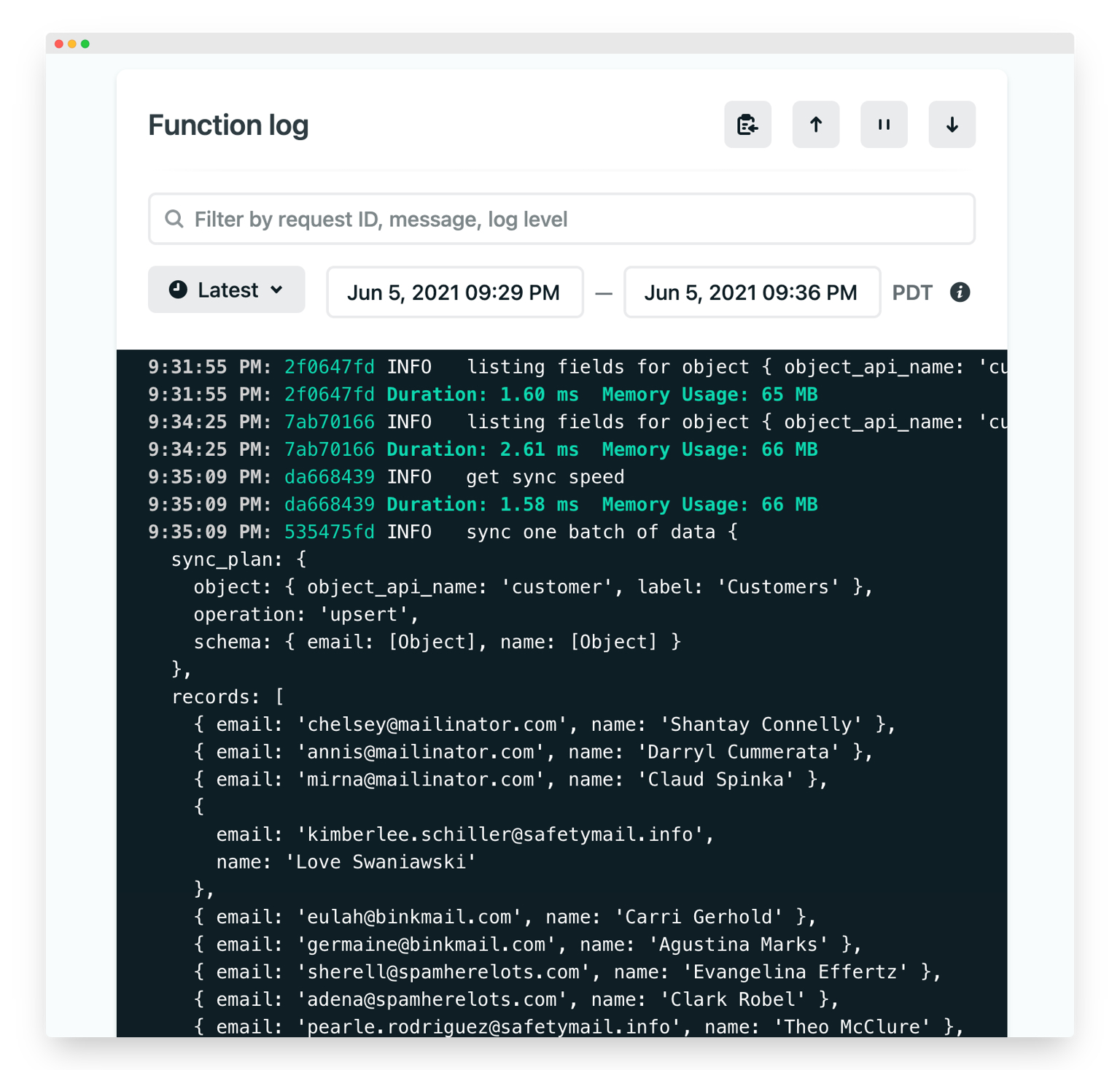
Concepts
Your Custom API is a bridge between Census and your destination SaaS or other system. Census syncs are divided into two phases, each of which will call different methods on your API: planning and execution.Sync Planning

list_objects- Get a list of the objects your API can write to.list_fields- Get a list of the fields, along with data types and validation rules, for a given object.supported_operations- Find out what kinds of “writes” can be performed on an object - can new instances be created? Can existing instances be modified?
Sync Execution

get_sync_speed- How quickly should Census send data to your API?sync_batch- Sync one batch of records to your destination, reporting success and failure for each record.
Objects and Fields
Every Census destination has a schema, which is made up of Objects and Fields. Objects are roughly analogous to tables in a database, whereas fields are like columns. Your Custom API destination will tell Census what its schema is as part of the planning process (via thelist_objects and list_fields methods). Census will use this information to populate its mapping API, and guide the users of your Custom API to map tables and columns in their data warehouse to your destination.
Every SaaS application has a different data surface it exposes to the world, and there is some art in deciding how to model SaaS data APIs as objects and fields. This also depends on the operations the SaaS application gives you (see below).
Many SaaS applications / destinations do not provide APIs to discover objects and fields. In this case, your Custom API should return a hard-coded list of objects and fields and return those to Census.
Operations
Destination systems may also have rules about what can be done with new and existing data. Census will send anoperation field in the sync_batch call to indicate how the records should be processed. Census currently allows Custom APIs to choose from four operations for each object:
upsert(most common) - records in the destination can be created or modifiedinsert- records can only be created in the destination, they cannot be modifiedupdate- records can only be modified in the destination, they cannot be createdmirror- records will be created and deleted in the destination as they are added and deleted from the dataset
update records in the destination but not insert them, your Custom API must first check the destination to see if a matching record exists, and tell Census to skip it if it does not exist. Some destination systems may provide APIs like this for you (create this record only if it does not exist) if they have strong enforcement of uniqueness on identifiers.
When it comes to mirror syncs Census will send separate batches of records. For records that should be created and updated the batch will indicate an operation of upsert and for records that should be deleted from the destination the operation will be delete .
Matching Source and Destination Data
Every sync plan created by Census for aninsert, update, or upsert sync will include a field that should be used as the identifier for matching source and destination records. This field must be unique and required in both systems (the source data warehouse and the destination SaaS), and it will be provided for every record. Your Custom API will tell Census (via the list_fields method) which fields can be legally used as identifiers.
Security Considerations
The requests that Census makes to your Custom API may include sensitive data about your business or customers, and your API must protect that data. In addition, your API must protect any secrets or credentials that it will use to authenticate to the ultimate destination system. All connections from Census to a Custom API must use HTTPS with a certificate signed by a well-known CA - self-signed certificates are prohibited. Your Custom API URL can include a cryptographically unguessable segment that you can use to verify calls are coming from Census and not an imposter. For example, if your Custom API is hosted athttps://census-custom-api.yourcompany.example, you could configure Census to invoke it as https://census-custom-api.yourcompany.example?census_authentication=XoBcsUoFT82wgAcA and verify all calls include the correct census_authentication value.
Secrets needed by your Custom API can be stored in several places:
- In environment variables accessible to your Custom API - this is a common pattern supported by many API hosting platforms.
- In your application’s source code - this is usually a bad practice because source code may not be stored as securely as environmental variables, but this depends on your organization’s practices
- As query string or path segment parameters in your Custom API’s URL. To continue the example above, if your Custom API needs an API key to access the destination system, you could include it as a second parameter, i.e.
https://census-custom-api.yourcompany.example?census_authentication=XoBcsUoFT82wgAcA&api_key=Ur2NtbfiPuFSkdQp
Auth Token
You can specify a special authentication token for a Custom API connection and this token will be attached as anAuthorization header to every request. In the connection setup screen you will see an optional field:
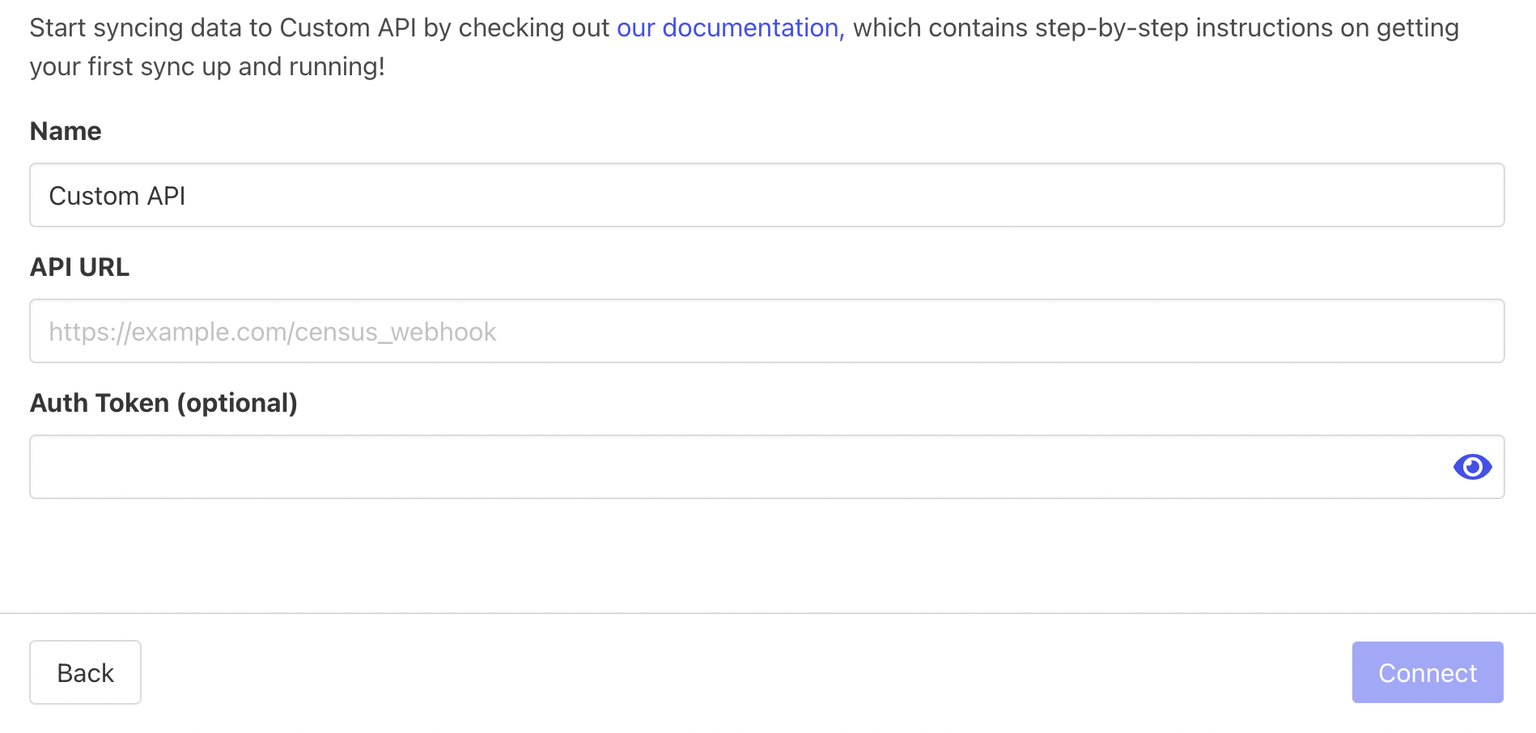
Custom API Connection setup card with Auth Token field
Authorization: Bearer <your string>. This avoids the need to add a token to the url. NOTE: Once a token credential has been set it can be changed but not removed.
Writing Your Custom API
Basic Request-Reply Message Format
Your Custom API will use an RPC-style protocol to communicate with Census. Every message from Census will be an HTTP POST whose body is a JSON object that includes these elements:method: The name of the method Census is calling on your API. Methods are included in request bodies (instead of as a RESTful-style URL component) so that you can give Census a single URL as the integration point.params: A JSON object (possibly empty) containing parameters for the methodid: A unique ID for the request. You must return this same ID in the responsejsonrpc: This will always be the string"2.0"
result: A JSON object that is the value you are returning from the method call. Can be empty, depending on the methoderror: Optional - allows you to return error information to Census in the event of a problem invoking your API. Theerrorproperty must not be present if there is aresultid: The sameidthat was passed in to the requestjsonrpc: This will always be the string"2.0"
https://example.com/census
HTTP Request
HTTP Response
sync_data method) within this time, you can use the get_sync_speed method to tell Census to send data more slowly until you are able to complete within this timeout.
Caching, State, and Parallel Invocations
The Custom API protocol is designed to allow you to implement your API in a completely stateless manner. Specifically:- Don’t cache data or metadata. Census will perform caching of your objects, fields, supported operations, etc. automatically, with policies to refresh stale data and controls for users to force invalidation. Adding additional caching may make your Custom API behave unusually in the Census UI.
- Don’t store any other durable state, especially service data, unless your Custom API is “part of” the destination system. Try to ensure that calls to
sync_batchresult in the data being actually persisted to the destination system - once you tell Census a record has been synced, Census may never send that record again (if it doesn’t change in the source) and Census has no way to know that it was “lost” from the destination system - Expect Census to send multiple requests to your Custom API in parallel. For performance, Census will retrieve / update schemas in parallel, and will sync data in parallel. You can control the degree of parallelism for syncs via the
get_sync_speedmethod.
Error Handling
Census will take care of most error handling on your behalf. Census uses a hierarchical retry strategy - single records or batches may be retried on failure, and full syncs may be retried if Census detects that a sync was incomplete. In addition, Census can automatically perform “full syncs” of the source data set if it detects certain conditions that can lead to loss of durability. Do not be surprised if Census tries to sync the same record to your destination multiple times - this is a normal part of our recovery-oriented sync runner. Census provides three “channels” for your Custom API to return errors:- If your Custom API fails to return an object with the correct keys, Census will fail with an “unknown error”. If you have enabled the Custom API debugger (see below), the error will be captured for later troubleshooting
- Your Custom API may return a structured error message and code in the error property of the JSON-RPC response object. This error code and message will be displayed in the Census UI.
- Two methods,
test_connectionandsync_batch, provide the ability to return application-level error messages. Fortest_connection, you can return a high-level error messsage helping the user debug why your Custom API may not be working.sync_batchrequires your Custom API to indicate a success or failure status for each record in the batch - error messages associated with record-level failures will be displayed in the Census Sync History UI
Rate Limiting
By default a Custom API connection has a connection-wide rate limit of 50,000 requests per second. This means that if two syncs are running simultaneously against the same custom connection they will both count against that rate limit. This limit can be overridden by returning aX-RateLimit-Limit header in the responses to our calls against your custom API. For example: if you want to cap requests to your custom service at 100 reqs/second then return X-RateLimit-Limit: 100 as a header in the responses from your service. Whatever value you set here is the limit per second.
NOTE*:* This is different than our operation to fetch the sync speed. In essence these are two rate limiting mechanisms working in tandem. get_sync_speed is designed to indicate how fast and parallel an individual sync can be while this X-RateLimit-Limit header is a connection wide limit that acts as a cap to ensure that multiple syncs running simultaneously do not overwhelm the same custom API destination.
RPC Versioning
Our Custom Destination RPC is versioned with the current version being v1. You can adjust the version you are targeting by editing the connection credentials in the Census app for that specific connection. The versioning scheme is simple: whenever we make a breaking change to the Custom Destination RPC interface we will increment the version and your existing connections should remain functional.
RPC Details
Your destination must implement all of these methods to work with Census:test_connection
Verify that the custom connection is working
Census calls this method when a user presses the “Test Connection” button on your custom connection. When this is invoked, you should do something to test that the connection to your upstream SaaS application is working correctly - specifically, it’s useful to verify API keys. Request This method has no parameters - the request parameters will always be an empty JSON objectlist_objects
List all the objects supported by the custom connection
Census calls this method periodically (in response to UI interaction as well as proactively in the background to warm its caches) to get the list of objects your destination supports as sync destinations. Your destination will be useless unless you respond with at least one object. Objects have both labels (for humans) and API names. These may be the same value, but they do not have to be. The API name is an identifier chosen by you that acts as the primary key for an object; an object’s label may change over time, but its API name must not. You should choose API names that correspond with long-lived identifiers in your destination SaaS. Objects can support creating new fields if thecan_create_fields property is set to on_write. This is useful for objects which can have arbitrary properties, like events. Census allows you to map new fields in the Sync creation UI but it’s on your API implementation to support ingesting and creating these new fields when they are received. Being able to create new fields is a requisite for an object supporting Sync All Properties.
Request
This method has no parameters - the request will always be an empty JSON object
list_fields
List all the fields for a given object
Census calls this method periodically to get the list of fields for a supported object. An object must have at least one field withidentifer set to true, or it cannot be the destination of a Census sync.
A field’s description consists of these required properties:
field_api_name(string): A unique, unchanging identifier for this fieldlabel(string): A human-friendly name for the fieldidentifer(boolean): If true, this field can act as a shared identifier in a Census sync. In order to be used an an identifier, a field must fulfill a few constraints:- It must be unique
- It must be required
- It should be easy to create or update records in the destination SaaS by this value
required(boolean): If true, a record cannot be created unless a values is specified for this field. Census will enforce this by requiring a mapping from a data warehouse column to this field before a sync can be performed.createable(boolean): If true, this field can be populated on record creation in the destination SaaS. This will be true for most fields. An example of a non-creatable field would be something like an auto-populated “Created At” timestamp that you’re not able to write to using the SaaS API.updateable(boolean): Similar tocreateable- if true, this field can be populated when updating an existing record. Generally speaking, if a field is neithercreateablenorupdateable, you might consider omitting it entirely from thelist_fieldsresponse, as it won’t be usable by Census for any syncs.type(string): The data type for this field. Census uses this to plan any “type casts” required to translate data from your data warehouse to your SaaS, to warn of invalid or lossy type casts, and will format the data on the wire to your custom destination using this type information. Ifidentifieristrue, the type must bestringorinteger. See the table below for the full list of types.array(boolean): If true, this field accepts an array of values instead of a single value. Any type can be used as anarraytype, butarraytypes cannot beidentifiers. Census will require array fields to have a matching array field in the mapped data warehouse column.
| Census Type | Can Be Identifier | JSON Wire Type | JSON Wire Example | Notes |
|---|---|---|---|---|
boolean | No | boolean | true | |
decimal | No | string | "1234.1234" | Fixed-point decimal numbers are sent as strings to avoid loss of precision |
float | No | number | 42.42 | Consider the decimal type instead for numeric data warehouse columns |
integer | Yes | number | 4242 | |
date | No | string | "2021-03-29" | JSON does not have a date type, so dates are ISO 8601 strings |
date_time | No | string | "2021-03-29T16:32:23Z" | JSON does not have a datetime or time type, so date times are ISO 8601 strings. All date_time values will be expressed in UTC |
string | Yes | string | "pepperoni" | String encoding follows the JSON standard |
supported_operations
List the operations that can be performed on an object
Census calls this method when a user is setting up a sync to your custom destination to determine how data should be copied to your object. You should advertise all the operations you are capable of supporting - the Census user will pick one of them from your supported list when they are configuring their sync. Currently, custom destinations support these operations:upsert: Look for a matching record in the SaaS - if it is present, update its fields with the new values, if not, create it. This is the most commonly used operation.insert: If a matching record is not present in the SaaS, create it. If it is present, skip syncing this record.update: If a matching record is present in the SaaS, update it with new field values. If it is not present, do not create it and skip syncing it.mirror: Upsert, plus if a previously synced row is no longer in the source, remove the matching record from the destination.
get_sync_speed
Tell Census what batch sizes and sync speeds should be used
Census will call this method just before a sync is starting to determine how quickly it should send data to your custom destination. In order to make your destination as easy to implement as possible, Census allows you to configure the batch sizes, maximum throughput, and maximum parallelism it should use when sending you data. Your response should include these three values:maximum_batch_size: How many records Census should include in each call tosync_batch(see below). Census may send smaller batches than this, but it will never send larger batches. If your SaaS API has a batch API, you should strongly consider setting this value to match you SaaS’s maximum batch size. If your SaaS does not have a batch import API, we recommend setting this to a relatively low value (under 100) then testing the performance of your custom destination with different batch sizes and increasing the value if needed for increased throughput.maximum_parallel_batches: How many simultaneous invocations ofsync_batchCensus will perform. It’s generally safe to set this to a large number and control your sync speed using the other two variables, but if your underlying infrastructure (web server or function-as-a-service provider) limits the number of parallel calls to your function, you should use this parameter to stay under that limit and avoid queueing at the network layer. NOTE: The maximum allowed value here is 50. If you set a higher number it will be set down to 50.maximum_records_per_second: How many records (not batches) Census will send to your custom destination per second, across all invocations. This should be matched to your SaaS API’s maximum records per second, possibly with some buffer to allow for measurement error. The actual records per second may be less than this value, depending onmaximum_batch_size,maximum_parallel_batches, and the average time it takes for your destination to complete one batch.